Got an inaccurate rifle? Maybe it’s time for a different handle.
Photo: One of the most unusual stocks on any rifle is this weird combination of walnut and metal on the Browning Buck Mark Rifle, a conversion from an autoloading pistol.
There was a time not long ago when a rifle was fitted with a wooden handle designed to aid the operator in using it quickly, easily and accurately. This was called the stock.
Rifles still wear stocks, but they’re decreasingly wood. They may be fiberglass, graphite, Kevlar, polyethylene, other moldable plastics, aluminum, laminated sheets of plywood or various combinations of any of these substances. The crazy thing is, they all work.
Yet they all have drawbacks.
It is up to each of us to understand stock options and choose those that work best on our rifles. To do this, it’s probably wise to ask ourselves what a rifle stock is for. What is its function? What is it supposed to do?
A stock is designed to help shooters manipulate their rifles to deliver bullets accurately on target.
But why so many shapes? High combs, Monte Carlo combs, wide combs, cheekpieces, open grips, straight grips, thumb holes, beavertails. The number of shapes seem endless. Why so many?
One reason for varying stock shapes is the worst reason — gratuitous design. Some folks just like to mess around with stocks for no functional end. Sometimes this does nothing more than insult one’s aesthetics; sometimes goofy designs interfere with performance. Even though stocks don’t move or operate like an action, they do perform certain tasks.
 Pressure Points
Pressure Points
A stock can help a barreled action be accurate, or hinder it. Rifle accuracy results from concentricity, consistency and balance in all its parts, including the ammunition.
Ideally everything should line up precisely with the center of the bore. The bore itself must be concentric and of a consistent diameter. It should vibrate/oscillate consistently with each shot. This is mainly the result of consistent ammunition.
If bullets are consistent and balanced, and powders develop consistent pressures, the barrel should oscillate consistently and bullets should fly to the same spot. A bad stock jeopardizes all this.
Changes in pressure against any part of the barreled action can alter the bullet impact point. This is what led to the innovations of glass bedding, pillar bedding, aluminum bedding blocks and the like. All are designed to eliminate odd pressure points that might bend the barrel or action and ruin bullet/bore alignment.
Stocks that are free-floating and glass-bedded also eliminate inconsistent pressure points that interfere with barrel vibrations.
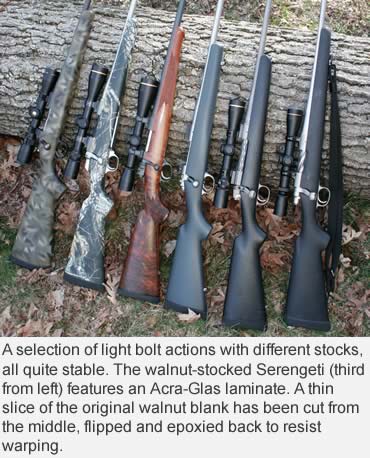 The wide, flat bottoms on some target and varmint rifles are made to remain stable and level on a sandbag. Flat, straight fore-end tips are supposed to butt against a fore-end tripod to create a consistent hold/pressure point.
The wide, flat bottoms on some target and varmint rifles are made to remain stable and level on a sandbag. Flat, straight fore-end tips are supposed to butt against a fore-end tripod to create a consistent hold/pressure point.
Extended butt heels, usually in the form of adjustable posts that slide up and down, are meant to anchor the butt and enhance accuracy by eliminating the need to hold the butt vertically.
Most often, a rear sandbag handles this chore. The slick surface of the butt should slide straight back over a sandbag, preventing snagging, which could alter bullet impact.
Mitigate/Control Recoil
Depending on its weight, shape and, to a lesser degree, material, a stock can significantly reduce felt recoil. Actual recoil is a product of the weight of the bullet and powder plus the muzzle velocity.
For every action, there is an opposite and equal reaction, so the energy the bullet carries when it leaves is slammed back in equal measure. Fortunately, we don’t suffer the same effects as the game we hit. Kinetic energy in the bullet doesn’t work the way we might imagine, partly because much of the “opposite reaction” force is lost as sound of the explosion, heat to the barrel, vibration to the atmosphere and impulse lost to move the weight of the rifle.
Felt recoil is subjective. A poorly designed stock emphasizes recoil by leaping up and whacking you in the face. A too-light stock won’t absorb much energy and kick harder. But a stock with a lot of drop in the comb will also slap you in the chops because the energy coming straight back from the barrel/chamber is suddenly directed down into declining stock, forcing its “opposite reaction” to kick up.
A straight butt with a high, straight or rising comb carries the recoil straight back into that nice, absorptive recoil pad and your shoulder, reducing the sharp slap.
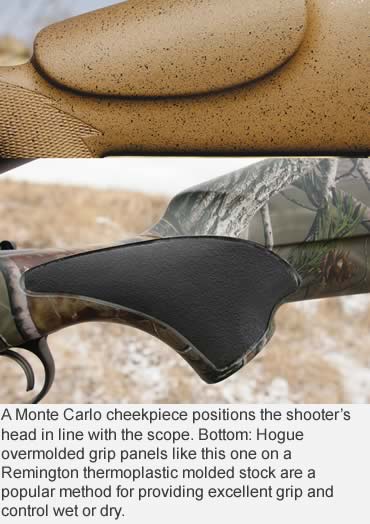 Recoil feels less. This is what’s behind the shape of a Monte Carlo stock, that humped back look most recognizable in a Weatherby. The Monte Carlo rises to keep recoil away from your face, but the back end plunges to a lower butt heel and toe.
Recoil feels less. This is what’s behind the shape of a Monte Carlo stock, that humped back look most recognizable in a Weatherby. The Monte Carlo rises to keep recoil away from your face, but the back end plunges to a lower butt heel and toe.
This permits the buttplate to fit better in your shoulder pocket while your eye remains aligned with the scope. In essence, the raised Monte Carlo comb provides a solid cheek weld. You don’t have to lift your face off the stock to see through the scope.
Augmenting the Monte Carlo’s performance is a raised cheekpiece. This angled bulge of material on the side of the butt is designed to fit snuggly against your cheek, spreading out recoil and preventing the stock from leaping up and slapping you. A fairly wide, gently rounded comb ridge similarly spreads out recoil while a thin, sharp comb ridge concentrates it, practically cutting into your cheekbone with recoil.
Even checkering is designed to control recoil. It provides grip so that your hands will hold and control the rifle so it comes straight back into your shoulder rather than riding up. Alternatives to checkering include sticky, rubber-like grip panels and sand particles mixed into paint or varnish. A few stocks include grooves in the fore-end for enhanced grip.
Some fore-ends are shaped like a triangle, wider at the bottom than top so your fingers can wrap in. Fore-end posts or vertical grip aids on AR-15-type rifles are another option for controlling vertical recoil. There are even rubbery, aftermarket vertical grips sold for attaching to any fore-end via the sling swivel stud.
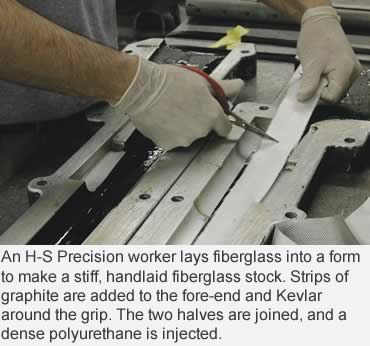 Comfort and Convenience
Comfort and Convenience
Some hunting stocks are built small and light to reduce carrying fatigue. Many military rifles sport butt stocks that adjust in length to accommodate a variety of shooters (length of pull). Many fold on a hinge to take up less space and be more portable.
Stocks with adjustable comb height, cast off and butt plate height permit the shooter to custom fit for maximum accuracy. These are seen almost exclusively on target rifles and some varmint rifles. Because these moveable parts don’t look slick, chic or elegant, they are usually left off custom hunting rifles whose stocks can be custom sized to the owner, anyway.
Most hunting rifles don’t feature adjustable stocks because of function and durability concerns. You don’t want a comb screw breaking or locking up in the middle of a hunt, and you don’t want to clean mud out of an adjustable butt plate recess.
Control Issues
How a rifle is used determines how it needs to be controlled. A hunting rifle can be whipped into action most easily and quickly if its stock is reasonably light and compact. Try throwing a target or varmint stock to your shoulder in a hurry, and you’ll understand.
A steep pistol grip may be more comfortable to hold than a straight or gently curved grip, but it is slower to whip into action. It’s also uncomfortable when carrying a rifle at the ready for a quick shot. The wrist bends too much. Vertical pistol grips and palm swells enhance control for accurate target shooting, but often get in the way for quick field shooting.
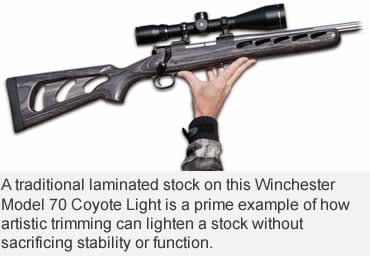 Part of the reason the Winchester Model 94 lever action has gained a reputation as a fast-handling brush gun is its straight-grip stock. No matter where your hand slips along the stock while carrying it, there is nothing to interfere with sliding it back up where it belongs to thumb back the hammer.
Part of the reason the Winchester Model 94 lever action has gained a reputation as a fast-handling brush gun is its straight-grip stock. No matter where your hand slips along the stock while carrying it, there is nothing to interfere with sliding it back up where it belongs to thumb back the hammer.
This is the problem with thumbhole stocks on hunting rifles. Like straight pistol grips, they provide more control for perfectly steadying a shot but slow down your shot because you have to pull your thumb out of the hole, wrap it up to disengage the safety, then wrap it back down and around to regain your grip. It’s not a big deal when you have all the time in the world, but troublesome when that hat-rack buck steps into a shooting window for only a second or two.
Flaring ends on pistol grips can prevent your trigger hand from sliding too far down the grip. That’s nice for consistency and accuracy, but counterproductive in a hunting rifle.
In general, the more a stock is designed for a tight, perfect fit during shooting, the slower it will be to put into action when hunting. Choose accordingly.
Art for Art’s Sake
When you begin to understand the function behind various stock designs, you also begin to question stock excesses like deep bellies in the fore-end, radical curves in the pistol grip, roll over combs, scalloped butt plates and deep relief carvings of acorns, oak leaves and royal stags in the side of the stock. Some might think a rosewood or ebony fore-end tip is art for art’s sake, but those were originally added to protect the end grain of the main stock.
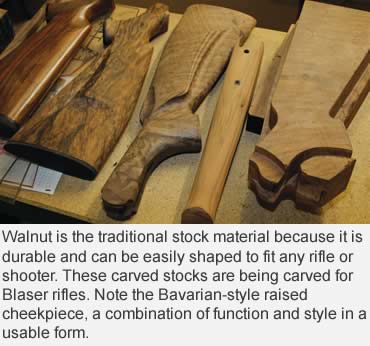 Materials
Materials
Walnut has been the stock of choice for centuries because it is abundant, renewable, durable, consistent, easily formed, shaped, checkered and easily repaired. It’s also warm and can be strikingly beautiful, though you’ll pay dearly for that.
Recent complaints about walnut-shifting with moisture changes are overblown and can be alleviated by glass, aluminum or pillar bedding.
Walnut stocks are ideal for glass bedding by the owner because they can easily be sanded. Epoxy bedding compounds like Brownells Acraglas adhere perfectly to wood and virtually eliminate shifting/swelling concerns. This means you can order your next rifle with a pretty walnut stock, stiffen it with epoxy bedding if you want, and enjoy consistent accuracy plus the feel and look of classic walnut.
Laminated wood, like any plywood, is stronger and less susceptible to moisture because the grains lay so many ways. They’re virtually impregnated with epoxy. They don’t need to be glass bedded and come in many colors.
They’re inexpensive, too. Boyds’ Gunstocks sells them for as little as $70. If you don’t like the striped look, there’s the Kilimanjaro Rifle with its Stealth Lamination, just one stiffening laminate down the center. You can hardly detect it. The rest of the stock shows classic walnut grain.
Synthetic stocks come in two basic categories: handlaid and thermal molded. Handlaid stocks consist of fiberglass cloth with or without additional graphite fibers and Kevlar reinforcement (usually in the wrist/grip area) set in a matrix of epoxy. H-S Precision stocks from South Dakota are a good example. These can be hollow and remarkably light or filled with a variety of foam plastics.
All are impressively strong, resisting bending and twisting to a remarkable degree. They can be touched up by painting, and cracks can be repaired with fresh epoxy. Some include molded-in checkering, but this is often shallow and dull, providing minimal grip. Adding sand to the paint around the pistol grip and fore-end is usually more effective.
Some handlaid stocks use fiberglass pillars alone around their bedding screws. Others include aluminum pillars. Some include an aluminum bar down much of the fore-end into the grip area. All can be quite accurate. The biggest selling point is durability and resistance to weather. Water is not going to swell or degrade a fiberglass/epoxy stock.
Hollow thermal-molded stocks are the cheapest going and can be wonderfully accurate and consistent. They also can shift with temperatures and bend enough to impact barrels and actions. It depends on the plastic used.
Before buying, test such stocks yourself. How easily can you press the barrel into the stock channel? Can you twist the fore-end?
If a molded stock is built properly, it will hold a barreled action without bending, but it’s best if barrels are free-floated. Too-flexible molded stocks can be stiffened and bedded with epoxy. It just takes a few extra steps to remove oils so the epoxy sticks.
It’s also a good idea to drill extra anchor holes to provide more mechanical locks for the epoxy. Detailed directions come with Brownells’ Acraglas and Acraglas gel kits. This process makes for an inexpensive stock that’s almost as effective as a stiffer handlaid model.
Read Recent GunHunter Articles:
• America’s Most Popular OU: A very high-quality shotgun for the price, the Browning Citori holds up to extensive shooting.
• Field Shooting Effectively: When your target of opportunity knocks, you need to answer in seconds.
This article was first printed in the July 2011 edition of Buckmasters GunHunter Magazine. Subscribe today to have GunHunter delivered to your home.